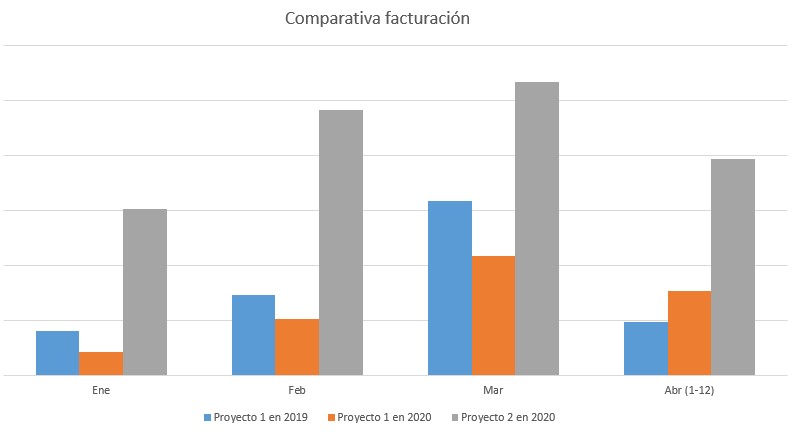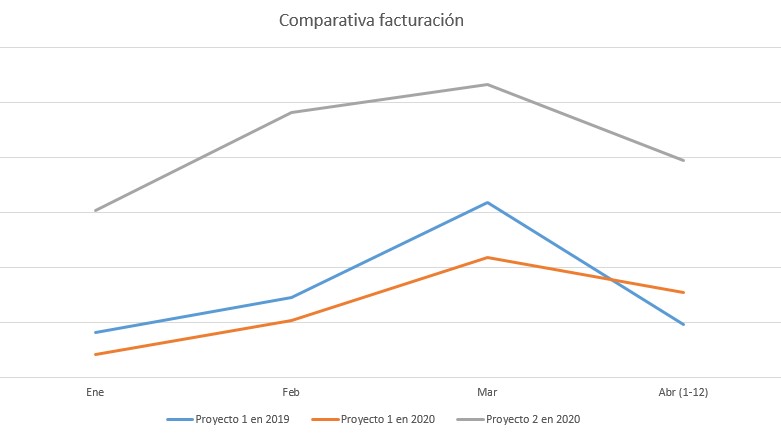Previous post
SEO factor prioritization: +75% revenue and organic usersHi, everybody!
Today I’m going to start a new section in our blog, we’re going to tell you about our recent (and not so recent) experience with projects in which we have participated or where we have directly worked the SEO part, both in large multinational corporations and in small SMEs with great vision to invest online.
The first case I would like to tell you about is a project of the second type, with a clear (a priori) seasonality, sales were mainly concentrated between the end of April and July, and how we managed not only to sell all year round, but also to prepare the project for a super-powerful entry into the “high season” of its main product.
In this project I participated leading the online area, where both paid (Google Adwords, search ads and shopping) and organic (content, link building, WPO and on page optimization) campaigns were carried out.
Would you like to know something I haven’t talked about or do you want me to go deeper into any other aspect?
Startup phase. Getting to know my client
To give context to the article and make it clear for us:
Project 1: Ecommerce with a start date of January 2017
Project 2: New Ecommerce (to test our team without touching project 1) with online start date April 25, 2019.
The situation was curious. My client had been working with an agency that did the web and Google Adwords campaigns (which had worked very well) and then was stuck. He was receiving data from his competitors and, after several investigations, it was clear to them that their share of the business could be much higher.
First they contacted another agency with whom they worked for 5 months… with no progress.
Then, they contacted my development team and began talks. We quickly set up a meeting at their offices to try to understand their business, where my involvement began. It was time to listen and start adding value. After a meeting of almost 8 hours, we went home with many concepts and many ideas to put on the table, analyze and prioritize to try to turn them into an online strategy.
Market research and potential profiling
They provided us with information about their business at all levels.
- What they did
- Where to buy
- What was more or less profitable
- Time for suppliers to provide merchandise
- History of the company and its evolution
- Etcetera.
We analyze everything and carry out competition and market studies of each product area: traffic, potential, competitors’ strategies, SWOT…
This was the evolution of visibility of the project they had active:

Buyer persona
We built several profiles of potential users for each area, analyzing the traffic they had and conducting surveys of the last 100 purchases.
The necessary equipment
To begin with, we proposed the following profiles:
- 1 Strategic SEO
- 1 SEO of content
- 1 licensed writer with advanced SEO training
- 1 SEM consultant specialized in Ecommerce
- 1 full back and front end team for web development with advanced SEO training
Planning Phase
After getting to know each other well, the possibility of expanding the product catalog was considered in order to try to reach potential users all year round. Their product was too seasonal, but one of the partners had direct contact with a manufacturer of a complementary product that could give them work in the slack periods of business.
All the analysis had already served its purpose… and it really did!
First steps in SEO
What a lot of data! We had the boards full of vital information to move and to start as soon as possible.
We carried out a complete analysis of our client’s catalog, studying all the business areas separately.
In each one we carried out micro studies to analyze the universe of keywords that responded to the purchasing needs of each of the individual buyers.
Example: Felipe, who is between 25 and 35 years old, loves to find the best price. We need to give him a price comparison against the competition and get our prices in Google in the SERPs.
From this diagonal reading of a buyer, we can already extract different things that should be included in our SEO strategy and within our website:
- Comparative tables
- Structured product data
- Clear price oriented information in the product sheet
- Real comparisons made known through publication on third party websites that have users similar to Felipe
- Adwords oriented ads
- Google Shopping (great source of comparison)
- Etc.
Objectives
At this point, we could only talk about the objectives of the project.
We started in January, there were only four months left to start the high season. The first thing we said to the client was that we were already a little late that season, we had to be completely agile if we wanted to get results, at least from the paid campaigns.
Furthermore, we didn’t have access to our client’s Adwords account (given that the agency that was running it, considered it its own, something that we should always be careful to avoid), nor did they have the conversions in Analytics or Adwords accounted for, we had to be a little blind in the channel analysis.
We prepared three different scenarios of possible objectives and a monthly budget in which to achieve them, which could only be modified if the profitability ratios were favorable. The client chose the most ambitious one. They had a catalog that worked, processes that allowed them to be agile and the necessary will to achieve it.
We were ready to continue:
- We knew our client.
- We knew their potential customers.
- We had clear and defined objectives.
Architecture and keyword universe
In order to develop a user-oriented strategy, the first thing we did was to analyze the universe of keywords for each business area and set of personal buyers based on all the information we had.
Many times, introducing certain types of things into an architecture is not an easy task. We proposed several scenarios and in the end we made a rather curious mix to try to achieve the scalability that we were looking for.
Here are a couple of links about these topics:
Steps to make a keyword research (somewhat outdated but the foundations are there)
Custom web development
The mockups
With all the information from the studios and the buyer person, we made a series of mockups of each type of page that we had defined in the architecture and that should have the Ecommerce. For us these are the bases of this work:
- It must be a clear map of the total scope of the project.
- Each type of page must be represented in mobile, desktop and tablet.
- Starting with the mobile mockup, the content of each type of page is defined.
- You must define the necessary headers, footers, images, forms …
- You must have clear the basic structure of the internal linking of the web.
- It must contain a first proposal for placement of elements at the design level.
- It must contain the SEO bases of the semantic tagging in each type of attached page.
- It must contain information about the operation of the proposed elements (what happens when I click on that button or that link, etc)
- It should speed up the work of the developers as much as possible.

Here I explain some things about how to create a sales page that converts.
WPO as a premise
One of the clear weak factors that we extracted from the SWOT was the speed of the ecommerce being sold in the market. For that reason, the speed of response of the page had to be a priority.
We analyzed the needs of the project against the various technologies that we had to hand. We have a team with more than 10 years of experience developing online stores in different CMS. We opted for WordPress for the back (an important weight was the learning curve that we saved, since the company already knew how to handle it from the previous web) and the whole front part was developed completely customized and optimized.
The mockup allowed the developers to have all the necessary SEO indications beforehand. All types of custom pages were created, as well as a whole battery of optimized shortcodes ready to be used at any time and on any type of page; thanks to them, generating quality content, internal links, etc. was much easier.
We optimized absolutely everything, even the feedback verification system, which added up to a lot of requests in the product sheets. We talked to the support team of that multinational and asked them how to optimize it, which also saved the customer 90 euros / month (the cost of integrating the opinions in the product file of that company).
You may be interested in this article on how to optimize images for SEO.
Quality content
Strategy on many occasions is everything. We already had a lot of information about the sector, about what we were looking for, as well as the content of the entire basic architecture of the website. The initial briefing to the editors was splendid.
For each category and subcategory, the following steps were taken:
- Journalistic and SEO documentation about the provider’s and competitor’s content, analyzing which part could be transactional and which part informational or blog.
- Micro keyword research, to get keywords, synonyms, variations, etc. that would build micro universes that could be linked internally or externally, optimized and clearly monitored throughout the strategy.
- A proposal was made for a hierarchy of headings of all transactional documentation for each category.
- It was completed with the revision of the competition content and TF-IDF tools.
- It was sent to the client to be validated.
- It was written following a strict style guide and SEO guidelines.
- A proposal of titles and meta descriptions was made from SEO writing to be validated by the SEO responsible for content.
- An orthographic, style and voice correction was performed, in addition to checking the follow-up of the proposed header structure.
- The content within the website was also designed and tested.
- It was analyzed with Safecont cluster by cluster to detect possible anomalies.
Here you have in more detail all the steps we followed for the SEO writing of quality content. Even with something that I’m sure you will like, a test without cost so you can assess the work we do for our customers and we have been outsourcing for a few months to third party projects (agencies, freelance, etc).
Evolution of the projects
The evolution of the main keyword

The evolution of the number of users

The graph you see is by the week, which means that this month we are in an upward trend to easily surpass the 2,000 weekly users, something that they had not even nearly achieved in project 1.
Consequences of a good work
The results achieved in this project led the client to hire us to carry out the SEO of its other line of business, a consolidated project in its sector, with an annual turnover of close to 300,000 euros and a conversion rate close to 2.5%.

So a priori, this is very good data, but the market was much larger.
I have marked the date when we started working on that website after gaining confidence with the other project.
Competitor to overcome
This week I received an audio from one of the partners asking me a couple of questions and indicating that I was looking forward to beating X competitor. My answer was clear and convincing, sending 2 screenshots, the one with the main keyword that I put at the beginning of the post and this one, where the competitor (blue) and us (red) appear:

Comparative billing
However, visibility without billing is nothing: the customer needs to make money from your business and one thing must be the consequence of the other. Here I show you the comparative billing graph between:
- Project 1 in 2019 (blue)
- Project 1 in 2020 (orange)
- Project 2 in 2020 (grey – started at the end of April 2019)

Or seen in another simpler way…

In these graphs you can clearly see how:
- The turnover of the new website (project 2) is several times that of the website they already had.
- The website they had (project 1) begins the year below the previous year and this April we managed to reverse that situation.
Would you like to know something that I haven’t talked about or do you want me to go deeper into some other aspect?
